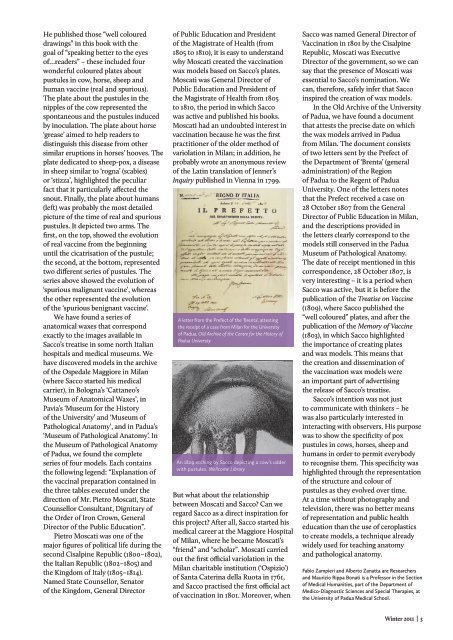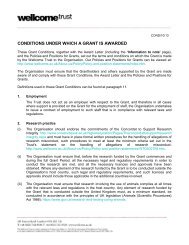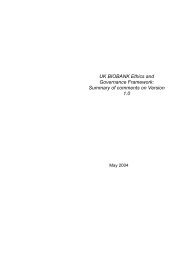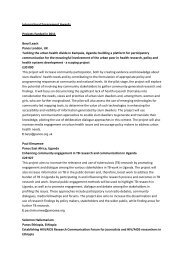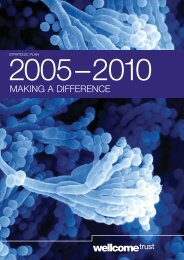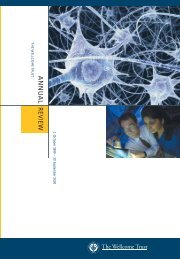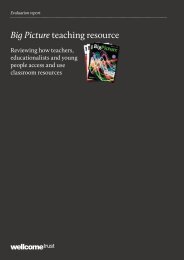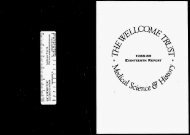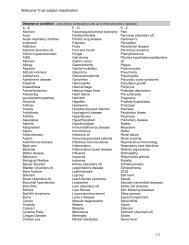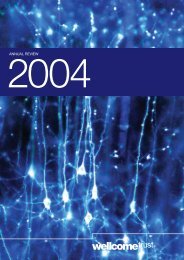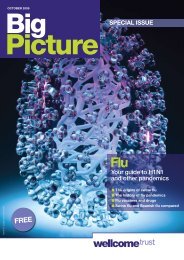(1839–1910) Medical history in Japan - Wellcome Trust
(1839–1910) Medical history in Japan - Wellcome Trust
(1839–1910) Medical history in Japan - Wellcome Trust
You also want an ePaper? Increase the reach of your titles
YUMPU automatically turns print PDFs into web optimized ePapers that Google loves.
He published those “well coloureddraw<strong>in</strong>gs” <strong>in</strong> this book with thegoal of “speak<strong>in</strong>g better to the eyesof…readers” – these <strong>in</strong>cluded fourwonderful coloured plates aboutpustules <strong>in</strong> cow, horse, sheep andhuman vacc<strong>in</strong>e (real and spurious).The plate about the pustules <strong>in</strong> thenipples of the cow represented thespontaneous and the pustules <strong>in</strong>ducedby <strong>in</strong>oculation. The plate about horse‘grease’ aimed to help readers todist<strong>in</strong>guish this disease from othersimilar eruptions <strong>in</strong> horses’ hooves. Theplate dedicated to sheep-pox, a disease<strong>in</strong> sheep similar to ‘rogna’ (scabies)or ‘stizza’, highlighted the peculiarfact that it particularly affected thesnout. F<strong>in</strong>ally, the plate about humans(left) was probably the most detailedpicture of the time of real and spuriouspustules. It depicted two arms. Thefirst, on the top, showed the evolutionof real vacc<strong>in</strong>e from the beg<strong>in</strong>n<strong>in</strong>guntil the cicatrisation of the pustule;the second, at the bottom, representedtwo different series of pustules. Theseries above showed the evolution of‘spurious malignant vacc<strong>in</strong>e’, whereasthe other represented the evolutionof the ‘spurious benignant vacc<strong>in</strong>e’.We have found a series ofanatomical waxes that correspondexactly to the images available <strong>in</strong>Sacco’s treatise <strong>in</strong> some north Italianhospitals and medical museums. Wehave discovered models <strong>in</strong> the archiveof the Ospedale Maggiore <strong>in</strong> Milan(where Sacco started his medicalcarrier), <strong>in</strong> Bologna’s ‘Cattaneo’sMuseum of Anatomical Waxes’, <strong>in</strong>Pavia’s ‘Museum for the Historyof the University’ and ‘Museum ofPathological Anatomy’, and <strong>in</strong> Padua’s‘Museum of Pathological Anatomy’. Inthe Museum of Pathological Anatomyof Padua, we found the completeseries of four models. Each conta<strong>in</strong>sthe follow<strong>in</strong>g legend: “Explanation ofthe vacc<strong>in</strong>al preparation conta<strong>in</strong>ed <strong>in</strong>the three tables executed under thedirection of Mr. Pietro Moscati, StateCounsellor Consultant, Dignitary ofthe Order of Iron Crown, GeneralDirector of the Public Education”.Pietro Moscati was one of themajor figures of political life dur<strong>in</strong>g thesecond Cisalp<strong>in</strong>e Republic (1800–1802),the Italian Republic (1802–1805) andthe K<strong>in</strong>gdom of Italy (1805–1814).Named State Counsellor, Senatorof the K<strong>in</strong>gdom, General Directorof Public Education and Presidentof the Magistrate of Health (from1805 to 1810), it is easy to understandwhy Moscati created the vacc<strong>in</strong>ationwax models based on Sacco’s plates.Moscati was General Director ofPublic Education and President ofthe Magistrate of Health from 1805to 1810, the period <strong>in</strong> which Saccowas active and published his books.Moscati had an undoubted <strong>in</strong>terest <strong>in</strong>vacc<strong>in</strong>ation because he was the firstpractitioner of the older method ofvariolation <strong>in</strong> Milan; <strong>in</strong> addition, heprobably wrote an anonymous reviewof the Lat<strong>in</strong> translation of Jenner’sInquiry published <strong>in</strong> Vienna <strong>in</strong> 1799.A letter from the Prefect of the ‘Brenta’, attest<strong>in</strong>gthe receipt of a case from Milan for the Universityof Padua. Old Archive of the Centre for the History ofPadua UniversityAn 1809 etch<strong>in</strong>g by Sacco depict<strong>in</strong>g a cow’s udderwith pustules. <strong>Wellcome</strong> LibraryBut what about the relationshipbetween Moscati and Sacco? Can weregard Sacco as a direct <strong>in</strong>spiration forthis project? After all, Sacco started hismedical career at the Maggiore Hospitalof Milan, where he became Moscati’s“friend” and “scholar”. Moscati carriedout the first official variolation <strong>in</strong> theMilan charitable <strong>in</strong>stitution (‘Ospizio’)of Santa Cater<strong>in</strong>a della Ruota <strong>in</strong> 1761,and Sacco practised the first official actof vacc<strong>in</strong>ation <strong>in</strong> 1801. Moreover, whenSacco was named General Director ofVacc<strong>in</strong>ation <strong>in</strong> 1801 by the Cisalp<strong>in</strong>eRepublic, Moscati was ExecutiveDirector of the government, so we cansay that the presence of Moscati wasessential to Sacco’s nom<strong>in</strong>ation. Wecan, therefore, safely <strong>in</strong>fer that Sacco<strong>in</strong>spired the creation of wax models.In the Old Archive of the Universityof Padua, we have found a documentthat attests the precise date on whichthe wax models arrived <strong>in</strong> Paduafrom Milan. The document consistsof two letters sent by the Prefect ofthe Department of ‘Brenta’ (generaladm<strong>in</strong>istration) of the Regionof Padua to the Regent of PaduaUniversity. One of the letters notesthat the Prefect received a case on28 October 1807 from the GeneralDirector of Public Education <strong>in</strong> Milan,and the descriptions provided <strong>in</strong>the letters clearly correspond to themodels still conserved <strong>in</strong> the PaduaMuseum of Pathological Anatomy.The date of receipt mentioned <strong>in</strong> thiscorrespondence, 28 October 1807, isvery <strong>in</strong>terest<strong>in</strong>g – it is a period whenSacco was active, but it is before thepublication of the Treatise on Vacc<strong>in</strong>e(1809), where Sacco published the“well coloured” plates, and after thepublication of the Memory of Vacc<strong>in</strong>e(1803), <strong>in</strong> which Sacco highlightedthe importance of creat<strong>in</strong>g platesand wax models. This means thatthe creation and dissem<strong>in</strong>ation ofthe vacc<strong>in</strong>ation wax models werean important part of advertis<strong>in</strong>gthe release of Sacco’s treatise.Sacco’s <strong>in</strong>tention was not justto communicate with th<strong>in</strong>kers – hewas also particularly <strong>in</strong>terested <strong>in</strong><strong>in</strong>teract<strong>in</strong>g with observers. His purposewas to show the specificity of poxpustules <strong>in</strong> cows, horses, sheep andhumans <strong>in</strong> order to permit everybodyto recognise them. This specificity washighlighted through the representationof the structure and colour ofpustules as they evolved over time.At a time without photography andtelevision, there was no better meansof representation and public healtheducation than the use of ceroplasticsto create models, a technique alreadywidely used for teach<strong>in</strong>g anatomyand pathological anatomy.Fabio Zampieri and Alberto Zanatta are Researchersand Maurizio Rippa Bonati is a Professor <strong>in</strong> the Sectionof <strong>Medical</strong> Humanities, part of the Department ofMedico-Diagnostic Sciences and Special Therapies, atthe University of Padua <strong>Medical</strong> School.W<strong>in</strong>ter 2011 | 3


